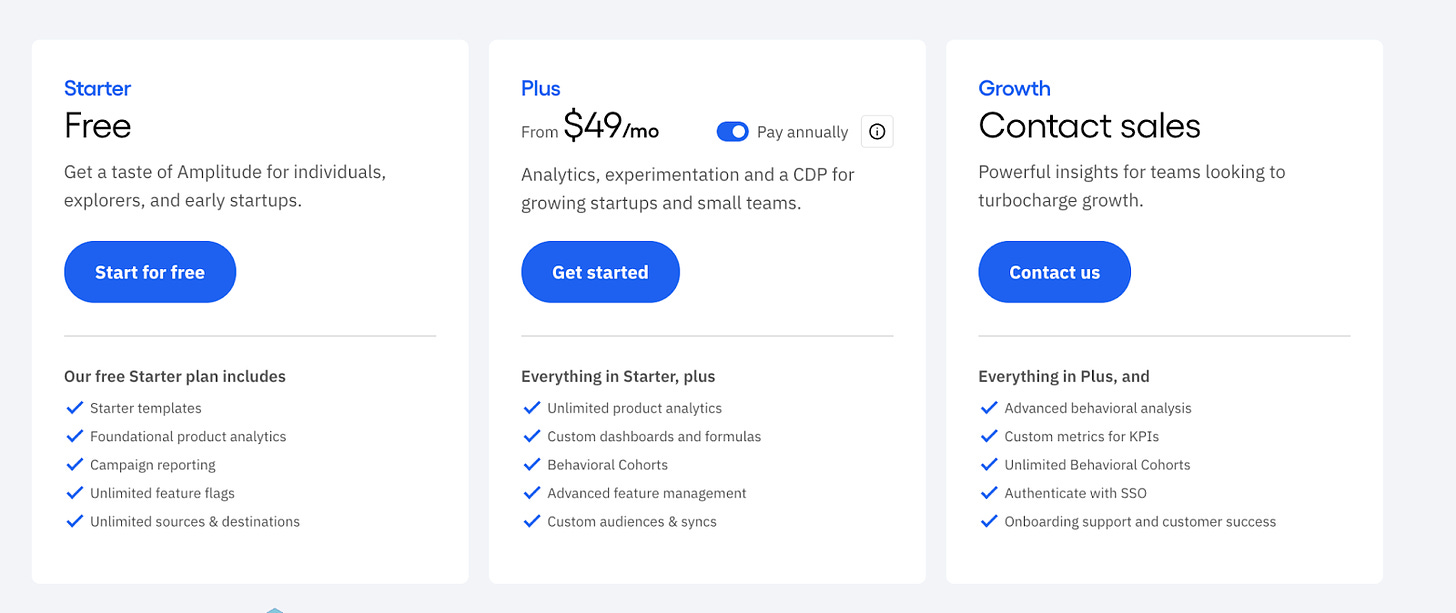- All things growth
- Posts
- Self-serve monetization vs. product-led sales monetization 💸
Self-serve monetization vs. product-led sales monetization 💸
Welcome to my PLG newsletter, where I share insights as I learn and grow myself. Share feedback if you have any.
You might have heard about the power of self-serve monetization, or when your product monetizes users on its own.
That means your users don’t have to speak to a salesperson, instead they can simply add their credit card and purchase the next plan themselves.
This also means you don't have to hire more people to scale your business. The product does all the heavy-lifting for you.
Most B2B SaaS companies have a mix of self-serve monetization and product-led sales monetization.
For example, Amplitude uses self-serve monetization strategy with their Plus plan. However, if users want more out of Amplitude (usage / outcomes), they’d have to purchase a Growth plan and they’d have to talk to sales to do so since it's not self-serve (pic. 1).

Let’s unpack how both of these models work and when it’s appropriate.
Note: This is a demo version content, join my Product-Led Growth course to go deeper.
Self-Serve Monetization
Self-serve monetization is when a user is able to checkout on their own, without the need to talk to a sales person.
Generally, if companies are paying more than $10K average contract value (ACV), they’d want more hand-holding and assistance in the process. Anything below that amount could be self-serve.
Advantages:
Scalability
Reduced overhead costs
Reduced top-of-funnel friction
Great fit for startup / SMB segment
Challenges:
Lower average contract value (ACV). Usually $10k or less.
Limited customer onboarding support
Product-led Sales Monetization
A product-led monetization is when a customer needs to talk to sales to buy a plan.
This approach is well-suited for enterprise-level organizations where complex solutions require personalized guidance and consultation throughout the sales process.
The average contract value for these plans is usually higher than $10k.
In the case of Amplitude and many other successful PLG companies, users mature with the product, where they may start on a free plan, then upgrade themselves to the Plus plan (self-serve), and then buy Growth or Enterprise plan a few years after joining.
Advantages:
Higher customer lifetime value (LTV) and retention (3-year deal vs. a month-to month SaaS subscription)
Higher ARR
White-glove onboarding and implementation support
Challenges:
Immense friction on the top-of-funnel
Higher costs due to sales team involvement
Longer sales cycles
Comparative Analysis
Let’s compare both of these strategies across a few parameters: Customer Acquisition Cost (CAC), Customer Lifetime Value (CLV), Conversion rates, Suitability for different business sizes and types.
1. Customer Acquisition Cost (CAC):
Self-Serve: Generally lower CAC due to reduced sales team involvement and lower top-of-funnel friction.
Product-Led Sales: Higher CAC due to the need for personalized sales engagement and longer sales cycles.
2. Customer Lifetime Value (LTV):
Self-Serve: Typically lower LTV as customers may have limited onboarding support and lower contract values.
Product-Led Sales: Higher LTV attributed to white-glove onboarding, personalized guidance, and typically longer contract durations.
3. Conversion Rates:
Self-Serve: Higher conversion rates as customers can quickly make purchasing decisions without sales interactions.
Product-Led Sales: Lower conversion rates due to the need for sales involvement and longer sales cycles.
4. Suitability for Different Business Sizes and Types:
Self-Serve: Ideal for startups and SMBs due to scalability, lower friction to purchase, and lower initial investment requirements.
Product-Led Sales: Best for enterprise-level orgs where complex solutions require personalized guidance throughout the sales process, leading to higher contract values and longer-term relationships.
Wrap
Choosing the right monetization model for your B2B SaaS use cases is crucial for effectively managing revenue streams and maximizing product profitability.
While self-serve monetization offers scalability and reduced overhead costs, product-led sales monetization provides higher LTV and retention, but with higher CAC and longer sales cycles.
The choice between these 2 strategies depends on factors such as target customer segment, product complexity, product’s price point, and desired growth trajectory.
Learn how to effectively leverage both self-serve and product-led sales monetization in my Product-Led Growth course.